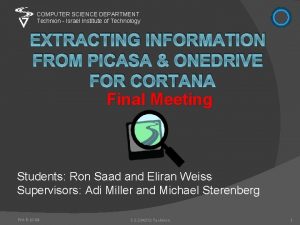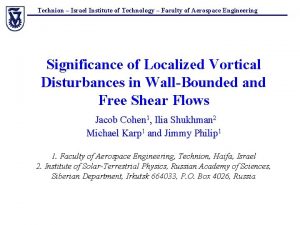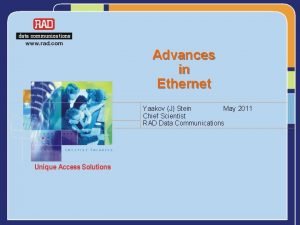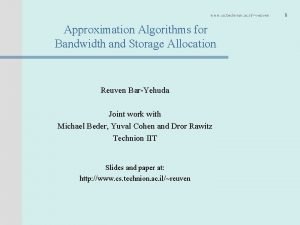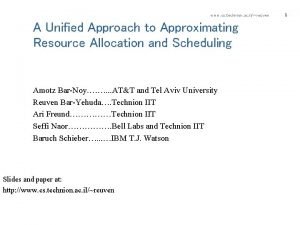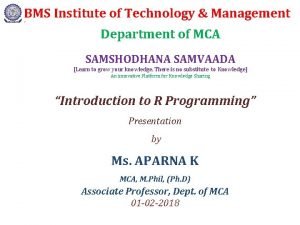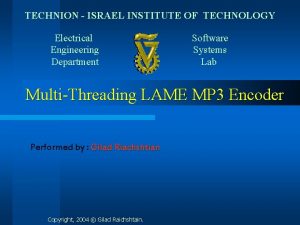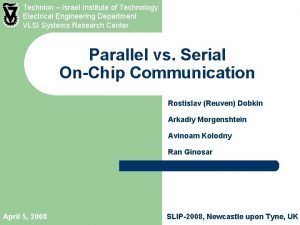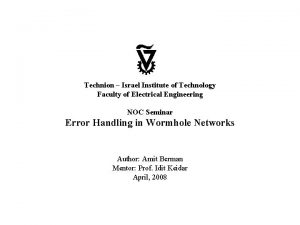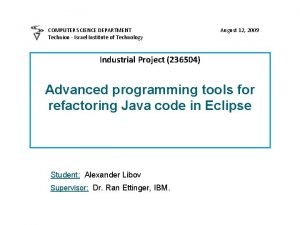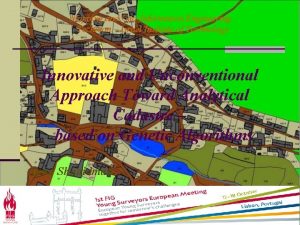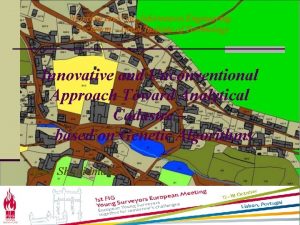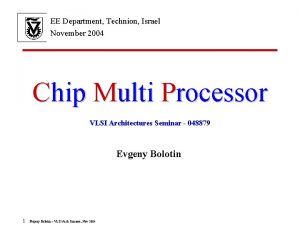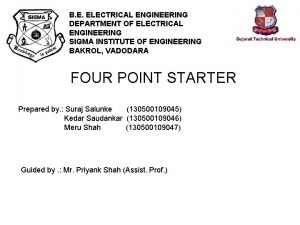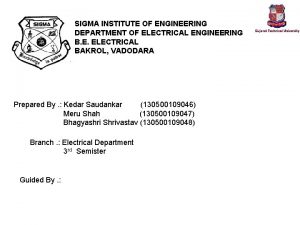Technion Israel Institute of Technology Electrical Engineering Department

































- Slides: 33

Technion – Israel Institute of Technology Electrical Engineering Department VLSI Systems Research Center Parallel vs. Serial On-Chip Communication Rostislav (Reuven) Dobkin Arkadiy Morgenshtein Avinoam Kolodny Ran Ginosar April 5, 2008 SLIP-2008, Newcastle upon Tyne, UK

Presentation Outline l Motivation – – l Link Architectures – – l "Register-Pipelined" and "Wave-pipelined" parallel links Single gate-delay serial link Comparative study: parallel vs. serial – – – 2 Parallel links limitations Novel high-speed serial links Analytical models Scalability 65 nm case study

Parallel link limitations N l Parallel links limitations – – – 3 Constructed of multiple (N) wires and repeaters Incur high leakage power Occupy large chip area (routing difficulty) Present a significant capacitive load Buses have often low utilization and most of the time just leak (line drivers and repeaters)…

Bit-Serial Interconnect l Fewer lines, fewer line drivers and fewer repeaters l Reduced leakage power Reduced chip area Better routability l l 4 l Should work N times faster!

Serial Link l l Standard serial links are very slow Hope lies in novel serial links – l This work considers the fastest serial link – l With single gate-delay data cycle (d 4) Our target: to show that novel serial link outperforms the parallel one for – – 5 Data cycle of a few gate-delays (inverter FO 4 delay) Long ranges Advanced technology nodes

Method l Choose – – l Compare the parallel and serial link approaches in terms of: – – 6 Parallel link implementation representatives Serial link implementation representatives Area Power Latency Technology scaling

"Register-Pipelined" Parallel Link l l l Fully synchronous Interconnect as combinational logic between registers Source synchronous or global clock High cost for high bit rates! 7

"Wave-Pipelined" Parallel Link G Bit rate is limited by relative skew of the link wires 8

Crosstalk Mitigation and Power Reduction l Shielding / Spacing Staggered repeaters Interleaved bi-directional lines Asynchronous signaling Data encoding Data pattern recognition with special worst-case handling l This work analyzes the two extremes of shielding: l l l – – 9 Unshielded wires (a) Fully-shielded wires (b)

Single Gate-Delay Serial Link l Transition signaling instead of sampling – l l 10 Two-phase NRZ Level Encoded Dual Rail (LEDR) asynchronous protocol, a. k. a. data-strobe (DS) Acknowledge per word instead of per bit Wave-pipelining over channel Differential encoding (DS-DE, IEEE 1355 -95) Low-latency synchronizers R. Dobkin, et al. , High Rate Wave-Pipelined Asynchronous On-Chip Bit-Serial Data Link, ASYNC 07

Analytical Models Parallel and Serial Link Bit Rates Ø Please refer to the paper for details on the exact analytical models employed in the work 11

Parallel Link Bit Rate Limitations (1( A. Fastest available clock – – – Ring oscillator limitation: 8 d 4 Fast processors: 11 d 4 (e. g. CELL) Standard So. C/ASIC: 100 -400 d 4 B. Synchronization Latency – May take several clocks in case of asynchronous clock relation C. Clock uncertainty – 12 Extended critical path

Parallel Link Bit Rate Limitations (2( D. Delay Uncertainty – – – The skew and jitter of the clock Repeater delay variations Wire delay variations Ø – – – Via variations Cross-Coupling (Crosstalk) Geometry Ø 13 mostly metal thickness variations Outcome of routing congestion and multi-layer structure N. S. Nagaraj DAC 2005 / L. Scheffer, SLIP 2006

Parallel Link Minimal Clock Cycle (1 ( Earliest data clocking Latest data clocking Clock Uncertainty Notations from W. P. Burleson, et al. , Wave-Pipelining: A Tutorial and Research Survey, TVLSI, 1998 14

Process Variations Impact on Multi-Wire Delay Uncertainty l Variation types – Random variations Ø – "Systematic" variations Ø l closely placed devices location on the die Relative skew ( MAX– MIN) – – – Repeaters in the same stage are highly correlated Random variations are averaged out thanks to large repeater sizing Systematic inter-stage variations are averaged out along the link Random variations inside Repeater Stage are averaged out ! Relative skew among the lines due to process variations is small 15

Cross-Coupling Impact on Multi-Wire Delay Uncertainty l Let’s approximate the wire delay by: transistor variation number of repeaters nominal repeater delay coupling factor Repeater Delay l 16 wire variation wire segment (L) nominal delay Wire Delay Worst case skew Φ between two lines:

Parallel Link Minimal Clock Cycle (2( l Minimal clock cycle: l System clock limitation: l Register-pipelined link: – 17 Distance between successive pipeline stages is affected by Delay Uncertainty The rate is bounded by clock cycle rather than the by the delay uncertainty 65 nm example

Serial Link Bit Rate l Skew due to in-die variation is neglected – l much smaller than in parallel link Coupling factor is always known – – LEDR encoding: there is only one transition per each transmitted bit The skew is not affected by cross-coupling Ø l 18 link delay is similar for all symbols Bit rate:

Scalability The range for serial link employment decreases with technology node scaling Number of repeaters grows with technology node scaling ü Number of repeaters (per ü ü ü millimeter) grows for more advanced technology nodes Active area and leakage: Minimal link length for serial link employment decreases with technology Dynamic power: Minimal link length for serial link employment decreases with technology Interconnect area: Serial link is always preferable Power Repeaters Area and Leakage Y. I. Ismail, et al. , Repeater Insertion in RLC Lines for Minimum Propagation Delay, ISCAS 99 19

65 nm Case Study 20

Goals and Set-up l Compare – – l In terms of: – – l Area Power Latency Length All links deliver the same bandwidth – 21 Wave-pipelined (shielded/unshielded) vs. Serial Register-pipelined (shielded/unshielded) vs. Serial BSER – the bandwidth of single serial link

Parallel Link Width for Equivalent Throughput l Note impractical widths for: Ø Unshielded WP over 6 mm Ø RP operating with clock cycle greater than 130∙d 4 Wave-Pipelined (WP) link width Register-Pipelined (RP) link width Maximal Width (128 Lines) Unshielded Equivalent Width Maximal Width (128 Lines) Fully-Shielded (8 d 4 Clock, N=8) 22

Wave-Pipelined Link vs. Serial Link: Active Area and Leakage Comparison Unshielded: Impractical Fully-Shielded Serial is better Unshielded Same Area / Leakage Parallel is better 23

Wave-Pipelined Link vs. Serial Link: Total Area Comparison (Incl. Interconnect) Unshielded: Impractical Unshielded 24 Serial is always better Fully-Shielded

Register-Pipelined Link vs. Serial Link: Active Area and Leakage Comparison Unshielded, T=10 d 4 Unshielded, T=130 d 4 Fully-Shielded, T=130 d 4 25 Serial is always better

Register-Pipelined Link vs. Serial Link: Total Area Comparison (Incl. Interconnect) Fully-Shielded, T=130 d 4 Unshielded, T=130 d 4 Fully-Shielded, T=10 d 4 Unshielded, T=10 d 4 26 Serial is always better

Wave-Pipelined Link vs. Serial Link: Dynamic Power Comparison Fully-Shielded Serial is better >3 mm Impractical: Too wide parallel link Unshielded: Impractical Unshielded 27 Parallel is better

Wave-Pipelined Link vs. Serial Link: Total Power Comparison 20% Utilization Unshielded: Impractical Fully-Shielded Unshielded 28

Register-Pipelined Link vs. Serial Link: Dynamic Power Comparison Unshielded, T=10 d 4 Fully-Shielded, T=10 d 4 Unshielded, T=130 d 4 Fully-Shielded, T=130 d 4 29

Register-Pipelined Link vs. Serial Link: Total Power Comparison 20% Utilization Unshielded, T=10 d 4 Unshielded, T=130 d 4 Fully-Shielded, T=130 d 4 30

Test Case Summary Minimal length above which the serial link is preferred Wave-Pipeline vs. Serial Shielding Length of parallel link Clock cycle of parallel link Fully Shielded unlimited up to 6 mm 8 d 4 To minimize the following: 31 Unshielded Register-pipelined vs. Serial Fully Shielded Unshielded unlimited 10 d 4 (fast) 130 d 4 (slow) choose a serial link for links longer than: Area Always Power 2 mm 4 mm 3 mm 1 mm 3 mm Latency 2 mm Never* 4 mm 12 mm 9 mm

Conclusions l l l Novel high-speed serial links outperform parallel links for long range communication The serial link is more attractive for shorter ranges in future technologies Future large So. Cs and No. Cs should employ serial links to mitigate: – – 32 Area Routing Congestion Power Latency

Thank You! April 5, 2008 SLIP-2008, Newcastle upon Tyne, UK
 Electrical engineering technion
Electrical engineering technion Rensselaer polytechnic institute electrical engineering
Rensselaer polytechnic institute electrical engineering Electrical engineering department
Electrical engineering department Tum department of electrical and computer engineering
Tum department of electrical and computer engineering Ucla systems engineering
Ucla systems engineering Vidhyadeep institute of engineering and technology
Vidhyadeep institute of engineering and technology Stevens institute of technology mechanical engineering
Stevens institute of technology mechanical engineering Mandava institute of engineering and technology
Mandava institute of engineering and technology Fromme423
Fromme423 One drive technion
One drive technion Technion aerospace
Technion aerospace Michael silverstein technion
Michael silverstein technion Ethertype 88f7
Ethertype 88f7 Technion
Technion Technion
Technion Technion
Technion Institute of certified public accountants in israel
Institute of certified public accountants in israel Define electrical technology
Define electrical technology Electrical technology chapter 2
Electrical technology chapter 2 Bet electrical technology
Bet electrical technology Electrical technology grade 12
Electrical technology grade 12 Calc institute of technology
Calc institute of technology Waterford institute of technology vacancies
Waterford institute of technology vacancies Spike unist internship
Spike unist internship Assistive technology implementation plan
Assistive technology implementation plan Masdar institute of science and technology
Masdar institute of science and technology Madhav institute of technology and science
Madhav institute of technology and science Grenoble institute of technology
Grenoble institute of technology Gas technology institute
Gas technology institute Field stop vs aperture stop
Field stop vs aperture stop Dbs institute of technology
Dbs institute of technology Materials technology institute
Materials technology institute Download r for windows
Download r for windows Vocational education uae
Vocational education uae









